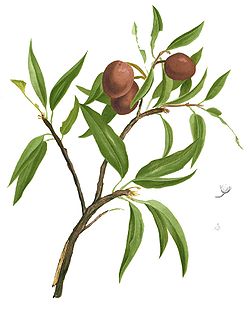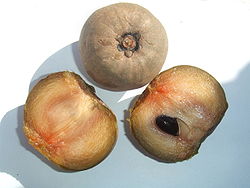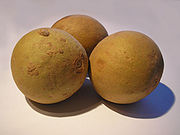- Manilkara zapota
-
Sapotillier
Sapotillier

Manilkara zapota Classification classique Règne Plantae Division Magnoliophyta Classe Magnoliopsida Ordre Ebenales Famille Sapotaceae Genre Manilkara Nom binominal Manilkara zapota
(L.) P. Royen, 1953Classification phylogénétique Ordre Ericales Famille Sapotaceae 
Sapotes
Parcourez la botanique sur Wikipédia :
Le sapotillier ou sapotier (Manilkara zapota ou Achras sapota) est un arbre fruitier originaire des Caraïbes et de l'Amérique centrale qui s'est ensuite répandu en Afrique et en Asie.Sommaire
Description
Le sapotillier est un arbre de taille moyenne qui peut atteindre 35 m de haut et dont le tronc ne dépasse pas 80 cm de diamètre.
Ses feuilles persistantes disposées en spirale sont légèrement dentées, elliptiques et mesurent 20 cm environ.
Son fruit, la sapote, est de forme variable (ronde à ovale) selon les variétés. Il contient de 3 à 12 graines marrons et dures avec un côté blanc entrouvert se terminant par un petit crochet.
Habitat, écologie
C'est un arbre de la strate arborescente supérieure de la forêt des régions humides et sèches des régions tropicales. Il supporte une culture jusqu'en zone USDA 8b (-8 °C) mais supporte très mal la sècheresse même momentanée.
Utilisations
On cultive le sapotier pour :
- L'arbre fournit un bois de haute qualité utilisé en ébénisterie.
- Il fournit également le chicle qui est une sorte de latex blanc utilisé autrefois dans la fabrication de la pâte à mâcher.
Divers
Les Mayas tiraient déjà profit du sapotillier. Ils fabriquaient, à partir du latex recueilli, des balles à jouer.
Références
Liens externes
- Référence Flora of Pakistan : Manilkara zapota (en)
- Référence Catalogue of Life : Manilkara zapota (L.) P.Royen (en)
- Référence Tela Botanica (Antilles) : Manilkara zapota (L.) P. Van Royen (fr)
- Référence ITIS : Manilkara zapota (L.) van Royen (fr) ( (en))
- Référence NCBI : Manilkara zapota (en)
- Référence GRIN : espèce Manilkara zapota (L.) P. Royen (en)
- (en) Fiche détaillée de l'université Purdue
- Portail de la botanique
- Portail des plantes utiles
Catégories : Flore (nom vernaculaire) | Sapotaceae | Arbre fruitier | Arbre tropical | Arbre du Mexique
Wikimedia Foundation. 2010.



